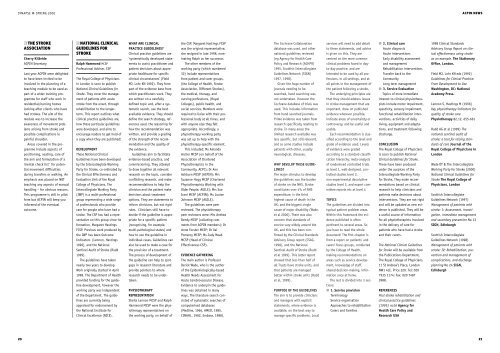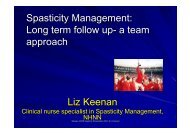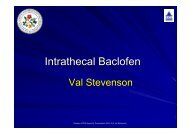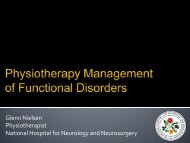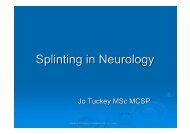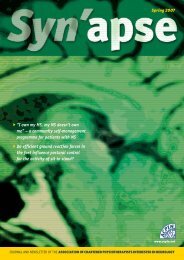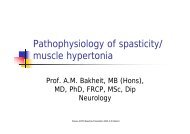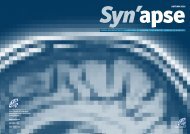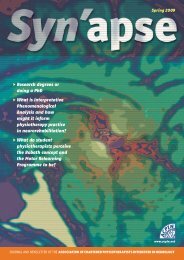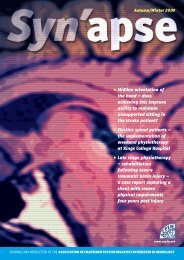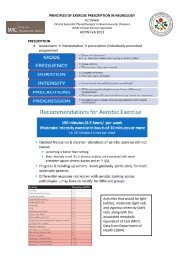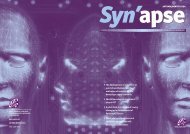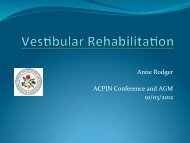Synapse SPRING 2000 - acpin
Synapse SPRING 2000 - acpin
Synapse SPRING 2000 - acpin
Create successful ePaper yourself
Turn your PDF publications into a flip-book with our unique Google optimized e-Paper software.
SYNAPSE ● <strong>SPRING</strong> <strong>2000</strong>ACPIN NEWS■N THE STROKEASSOCIATIONCherry KilbrideACPIN SecretaryLast year ACPIN were delightedto have been invited to beinvolved in the planning of ateaching module to be used aspart of a wider training programmefor staff who work inresidential/nursing homeslooking after clients who havehad strokes. The aim of themodule was to increase theawareness of movement problemsarising from stroke andpossible complications iepainful shoulder.Areas covered in the programmeinclude aspects ofpositioning, seating, care ofthe arm and formulation of a‘mental check list’ for potentialmovement difficultiesduring transfers or walking. Anemphasis was placed on NOTteaching any aspects of manualhandling – for obvious reasons.This programme is still in pilotform but ACPIN will keep youinformed of the eventualoutcome.■N NATIONAL CLINICALGUIDELINES FORSTROKERalph Hammond MCSPProfessional Adviser, CSPThe Royal College of Physiciansin London is soon to publishNational Clinical Guidelines forStroke. They cover the managementof patients with acutestroke from the onset, throughrehabilitation to the longerterm.This report outlines whatclinical practice guidelines are,how these particular guidelineswere developed, and aims toencourage readers to get hold ofa copy when they are published!DEVELOPMENTThese National ClinicalGuidelines have been developedby the Intercollegiate WorkingParty for Stroke, co-ordinated bythe Clinical Effectiveness andEvaluation Unit of the RoyalCollege of Physicians. TheIntercollegiate Working Party(IWP) is a multi-professionalgroup representing a wide rangeof professionals who providecare for people who have had astroke. The CSP has had a representativeon this group since itsformation, Margaret HastingsFCSP. Previous work produced bythe IWP has been OutcomeIndicators (Lennon, Hastings1996), and the NationalSentinel Audit of Stroke (Rudd1999).The guidelines have takennearly two years to develop.Work originally started in April1998. The Department of Healthprovided funding for the guidelinedevelopment, however theworking party was independentof the Department. The guidelinesare currently beingappraised for endorsement bythe National Institute forClinical Excellence (NICE).WHAT ARE CLINICALPRACTICE GUIDELINES?Clinical practice guidelines are‘systematically developed statementsto assist practitioner andpatient decisions about appropriatehealthcare for specificclinical circumstances’ (FieldMJ, Lohr KN 1992). They formpart of the evidence base fromwhich practitioners work. Theyare written on a carefullydefined topic and, after a systematicsearch, use the bestavailable evidence. They shoulddefine the search strategy, referencesused, the reasoning forhow the recommendation waswritten, and provide a gradingof the strength of the recommendationand the quality ofthe evidence.Guidelines aim to facilitateevidence-based practice, andcommissioning. They attemptto draw together all relevantresearch on the topic, considerconflicting research, and makerecommendations to help theclinician and the patient makedecisions about treatmentoptions. They are statements toinform clinicians, but not rigidrules. Clinicians still have todecide if the guideline is appropriatefor a specific patient(recognising, for example,multi-pathological states) andhow to use the guideline inindividual cases. Guidelines canalso be used to make a case forthe provision of a treatment.The process of development ofthe guideline can help to spotgaps in research literature andprovide pointers to whereresearch needs to be undertaken.PHYSIOTHERAPYREPRESENTATIONSheila Lennon MCSP and RalphHammond MCSP were the physiotherapyrepresentatives onthe working party, on behalf ofthe CSP. Margaret Hastings FCSPwas the original representative,she resigned in late 1998, nominatingRalph as her successor.The other members of theworking party (which numbered32) include representativesfrom patient and carer groups,(the College of Health, StrokeAssociation, Different Strokes),the medical, therapy, andnursing professions, (RoyalColleges), public health, andsocial services. Members wererequired to liaise with their professionalbody at all times, andwith anyone else they feltappropriate. Accordingly, aphysiotherapy working partywas set up to help with thephysiotherapy-specific element.This included: Ms AmandaArcher MCSP (on behalf of theAssociation of CharteredPhysiotherapists in theCommunity, ACPC); Dr AnnAshburn MCSP (ACPIN); MrsSuzanne Hogg MCSP (CharteredPhysiotherapists Working withOlder People, AGILE); Mrs SueIrani MCSP (ACPIN); Ms LouiseJohnson MCSP (AGILE).The guidelines were peerreviewed. The physiotherapypeer reviewers were: Mrs AntheaDendy MCSP (collating commentsfrom ACPIN members); DrAnne Forster MCSP; Dr ValPomeroy MCSP; Ms Judy MeadMCSP (Head of ClinicalEffectiveness CSP).EVIDENCE GATHERINGThe main author is ProfessorDerick Wade, who is the authorof the Epidemiologically-basedHealth Needs Assessment forAcute Cerebrovascular Disease.Evidence to underpin the guidelineswas obtained in manyways. The literature search consistedof systematic searches ofcomputerised databases(Medline, 1966, AMED, 1985,CINAHL, 1982, Embase, 1988).The Cochrane Collaborationdatabase was used, and othernational guidelines reviewed(eg Agency for Health CarePolicy and Research (ACHPR)1995, Scottish IntercollegiateGuidelines Network (SIGN)1997, 1998).Given the huge number ofjournals needing to besearched, hand searching wasnot undertaken. However theCochrane database of trials wasused. This includes informationfrom hand searched journals.Prime evidence was taken fromresearch specifically relating tostroke. In many areas thelimited research available wasless specific, but still relevant,and so some studies includepatients with other, usuallyneurological, diseases.WHY DEVELOP THESE GUIDE-LINES?The major stimulus to developthe guidelines was the burdenof stroke on the NHS. Strokeconstitutes over 4% of NHSexpenditure, is the thirdhighest cause of death in theUK, and the biggest singlecause of major disability (Wade,et al <strong>2000</strong>). There was alsoconcern that standards ofservice vary widely around theUK, and this has been confirmedby the Clinical StandardsAdvisory Group report (CSAG,1998), and the NationalSentinel Audit of Stroke (Ruddet al 1999). This latter reportshowed that less than half ofall Trusts have stroke units, andthat patients are managedbetter within stroke units (Ruddet al, 1999).PURPOSE OF THE GUIDELINESThe aim is to provide cliniciansand managers with explicitstatements, where evidence isavailable, on the best way tomanage specific problems. Localservices will need to add detailto these statements, and adviceis given on this. They arecentred on the more commonclinical problems faced in dayto-daypractice, and areintended to be used by all professions,in all settings, and atall points in the management ofthe patient following a stroke.The underlying principles arethat they should address issuesin stroke management that areimportant, draw on publishedevidence wherever possible,indicate areas of uncertainty orcontroversy, and be useful andusable.Each recommendation is classifiedaccording to the level andgrade of evidence used. Levelsof evidence were gradedaccording to a standard classificationhierarchy: meta-analysisof randomised controlled trialsas level 1, well-designed, controlledstudies level 2,non-experimental descriptivestudies level 3, and expert committeereports etc at level 4TOPICSThe guidelines are divided intotypical patient problem areas.Within this framework the evidencepublished is oftenpertinent to several areas. Soyou have to read the wholedocument! The first chapter isfrom a report on patients’ andcarers' focus groups, conductedby the College of Health,making recommendations onareas such as service development,knowledge of staff,shared decision-making, informationonce at home.The rest is divided into 3 sections:■ 1. Service provisionTerminologyService organisationApproaches to rehabilitationCarers and Families■ 2. Clinical careAcute diagnosisAcute interventionsEarly disability assessmentand managementRehabilitation interventionsTransfer back to theCommunityLong term management■ 3. Service EvaluationTopics of more immediateinterest to clinical physiotherapistsinclude motor impairment,spasticity, sensory impairment,functional rehabilitation interventions,activities of dailyliving, equipment and adaptations,and treatment followingdischarge.CONCLUSIONThe Royal College of Physiciansis soon to publish NationalClinical Guidelines for Stroke.These have been producedunder the auspices of theIntercollegiate Working Partyfor Stroke. They make recommendationsbased on clinicalresearch to help clinicians andpatients make decisions aboutinterventions. They are not rigidand will be updated as new evidenceis published. They will bea useful source of informationfor all physiotherapists involvedin the delivery of care forpatients who have had a strokeand their carers.The National Clinical Guidelinesfor Stroke will be available fromthe Publications Department,The Royal College of Physicians,11 St Andrew's Place, LondonNW1 4LE. Price £20. Tel: 0207935 1174; Fax: 020 74873988.REFERENCESPost-stroke rehabilitation andclinical practice guidelines(1995) no16 Agency forHealth Care Policy andResearch USA1998 Clinical StandardsAdvisory Group Report on clinicaleffectiveness using strokeas an example. The StationaryOffice, London.Field MJ, Lohr KN eds (1992)Guidelines for Clinical Practice:From Development to UseWashington, DC: NationalAcademy Press.Lennon S, Hastings M (1996)Key physiotherapy indicators forquality of stroke carePhysiotherapy 82,12, 655-661Rudd AG et al (1999) Thenational sentinel audit ofstroke: a tool for raising standardsof care Journal of theRoyal College of Physicians inLondonWade DT & The IntercollegiateWorking Party for Stroke (<strong>2000</strong>)National Clinical Guidelines forStroke The Royal College ofPhysicians, LondonScottish IntercollegiateGuidelines Network (1997)Management of patients withstroke: 1: Assessment, investigation,immediate managementand secondary prevention No 13SIGN, EdinburghScottish IntercollegiateGuidelines Network (1998)Management of patients withstroke: IV: Rehabilitation, preventionand management ofcomplications, and dischargeplanning No 24 SIGN,Edinburgh2021


